Maximilian Dreyer
Attribution-guided Pruning for Compression, Circuit Discovery, and Targeted Correction in LLMs
Jun 16, 2025Abstract:Large Language Models (LLMs) are central to many contemporary AI applications, yet their extensive parameter counts pose significant challenges for deployment in memory- and compute-constrained environments. Recent works in eXplainable AI (XAI), particularly on attribution methods, suggest that interpretability can also enable model compression by identifying and removing components irrelevant to inference. In this paper, we leverage Layer-wise Relevance Propagation (LRP) to perform attribution-guided pruning of LLMs. While LRP has shown promise in structured pruning for vision models, we extend it to unstructured pruning in LLMs and demonstrate that it can substantially reduce model size with minimal performance loss. Our method is especially effective in extracting task-relevant subgraphs -- so-called ``circuits'' -- which can represent core functions (e.g., indirect object identification). Building on this, we introduce a technique for model correction, by selectively removing circuits responsible for spurious behaviors (e.g., toxic outputs). All in all, we gather these techniques as a uniform holistic framework and showcase its effectiveness and limitations through extensive experiments for compression, circuit discovery and model correction on Llama and OPT models, highlighting its potential for improving both model efficiency and safety. Our code is publicly available at https://github.com/erfanhatefi/SparC3.
From What to How: Attributing CLIP's Latent Components Reveals Unexpected Semantic Reliance
May 26, 2025Abstract:Transformer-based CLIP models are widely used for text-image probing and feature extraction, making it relevant to understand the internal mechanisms behind their predictions. While recent works show that Sparse Autoencoders (SAEs) yield interpretable latent components, they focus on what these encode and miss how they drive predictions. We introduce a scalable framework that reveals what latent components activate for, how they align with expected semantics, and how important they are to predictions. To achieve this, we adapt attribution patching for instance-wise component attributions in CLIP and highlight key faithfulness limitations of the widely used Logit Lens technique. By combining attributions with semantic alignment scores, we can automatically uncover reliance on components that encode semantically unexpected or spurious concepts. Applied across multiple CLIP variants, our method uncovers hundreds of surprising components linked to polysemous words, compound nouns, visual typography and dataset artifacts. While text embeddings remain prone to semantic ambiguity, they are more robust to spurious correlations compared to linear classifiers trained on image embeddings. A case study on skin lesion detection highlights how such classifiers can amplify hidden shortcuts, underscoring the need for holistic, mechanistic interpretability. We provide code at https://github.com/maxdreyer/attributing-clip.
Mechanistic understanding and validation of large AI models with SemanticLens
Jan 09, 2025Abstract:Unlike human-engineered systems such as aeroplanes, where each component's role and dependencies are well understood, the inner workings of AI models remain largely opaque, hindering verifiability and undermining trust. This paper introduces SemanticLens, a universal explanation method for neural networks that maps hidden knowledge encoded by components (e.g., individual neurons) into the semantically structured, multimodal space of a foundation model such as CLIP. In this space, unique operations become possible, including (i) textual search to identify neurons encoding specific concepts, (ii) systematic analysis and comparison of model representations, (iii) automated labelling of neurons and explanation of their functional roles, and (iv) audits to validate decision-making against requirements. Fully scalable and operating without human input, SemanticLens is shown to be effective for debugging and validation, summarizing model knowledge, aligning reasoning with expectations (e.g., adherence to the ABCDE-rule in melanoma classification), and detecting components tied to spurious correlations and their associated training data. By enabling component-level understanding and validation, the proposed approach helps bridge the "trust gap" between AI models and traditional engineered systems. We provide code for SemanticLens on https://github.com/jim-berend/semanticlens and a demo on https://semanticlens.hhi-research-insights.eu.
Pruning By Explaining Revisited: Optimizing Attribution Methods to Prune CNNs and Transformers
Aug 22, 2024



Abstract:To solve ever more complex problems, Deep Neural Networks are scaled to billions of parameters, leading to huge computational costs. An effective approach to reduce computational requirements and increase efficiency is to prune unnecessary components of these often over-parameterized networks. Previous work has shown that attribution methods from the field of eXplainable AI serve as effective means to extract and prune the least relevant network components in a few-shot fashion. We extend the current state by proposing to explicitly optimize hyperparameters of attribution methods for the task of pruning, and further include transformer-based networks in our analysis. Our approach yields higher model compression rates of large transformer- and convolutional architectures (VGG, ResNet, ViT) compared to previous works, while still attaining high performance on ImageNet classification tasks. Here, our experiments indicate that transformers have a higher degree of over-parameterization compared to convolutional neural networks. Code is available at $\href{https://github.com/erfanhatefi/Pruning-by-eXplaining-in-PyTorch}{\text{this https link}}$.
Explainable concept mappings of MRI: Revealing the mechanisms underlying deep learning-based brain disease classification
Apr 16, 2024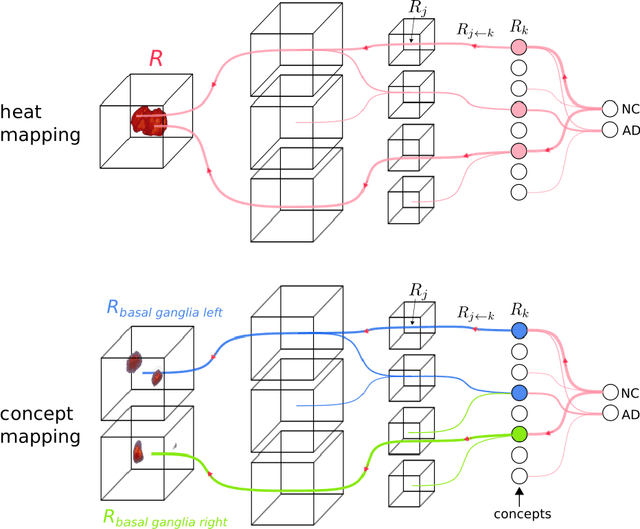
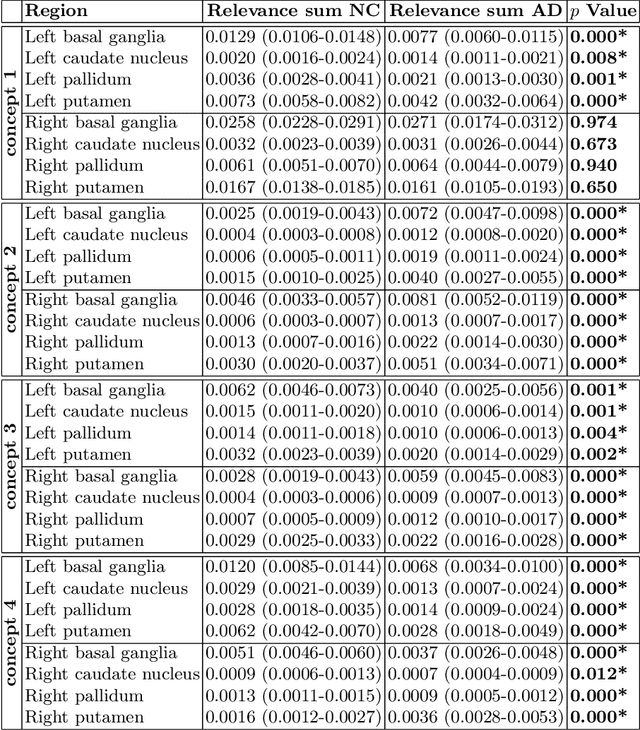
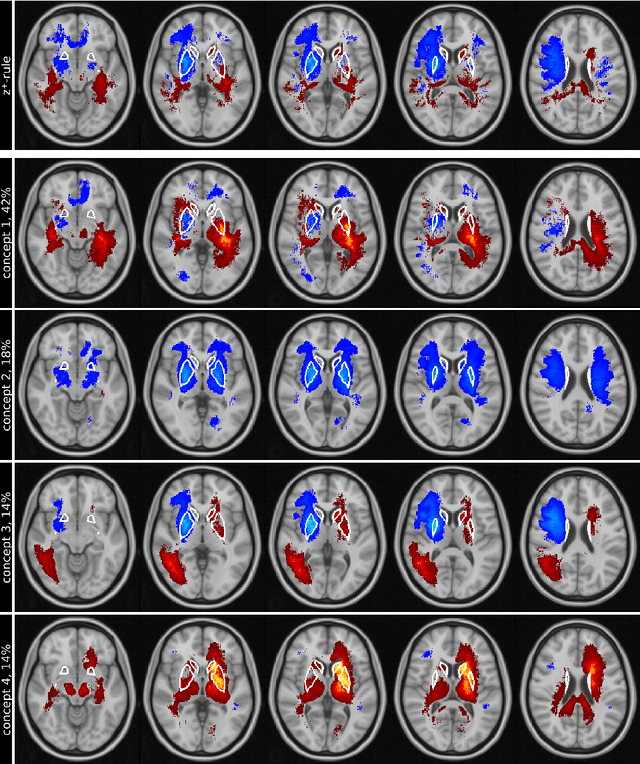
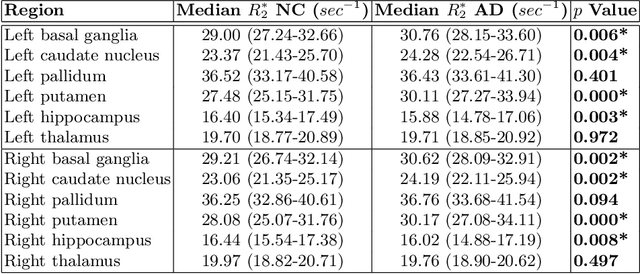
Abstract:Motivation. While recent studies show high accuracy in the classification of Alzheimer's disease using deep neural networks, the underlying learned concepts have not been investigated. Goals. To systematically identify changes in brain regions through concepts learned by the deep neural network for model validation. Approach. Using quantitative R2* maps we separated Alzheimer's patients (n=117) from normal controls (n=219) by using a convolutional neural network and systematically investigated the learned concepts using Concept Relevance Propagation and compared these results to a conventional region of interest-based analysis. Results. In line with established histological findings and the region of interest-based analyses, highly relevant concepts were primarily found in and adjacent to the basal ganglia. Impact. The identification of concepts learned by deep neural networks for disease classification enables validation of the models and could potentially improve reliability.
Reactive Model Correction: Mitigating Harm to Task-Relevant Features via Conditional Bias Suppression
Apr 15, 2024



Abstract:Deep Neural Networks are prone to learning and relying on spurious correlations in the training data, which, for high-risk applications, can have fatal consequences. Various approaches to suppress model reliance on harmful features have been proposed that can be applied post-hoc without additional training. Whereas those methods can be applied with efficiency, they also tend to harm model performance by globally shifting the distribution of latent features. To mitigate unintended overcorrection of model behavior, we propose a reactive approach conditioned on model-derived knowledge and eXplainable Artificial Intelligence (XAI) insights. While the reactive approach can be applied to many post-hoc methods, we demonstrate the incorporation of reactivity in particular for P-ClArC (Projective Class Artifact Compensation), introducing a new method called R-ClArC (Reactive Class Artifact Compensation). Through rigorous experiments in controlled settings (FunnyBirds) and with a real-world dataset (ISIC2019), we show that introducing reactivity can minimize the detrimental effect of the applied correction while simultaneously ensuring low reliance on spurious features.
PURE: Turning Polysemantic Neurons Into Pure Features by Identifying Relevant Circuits
Apr 09, 2024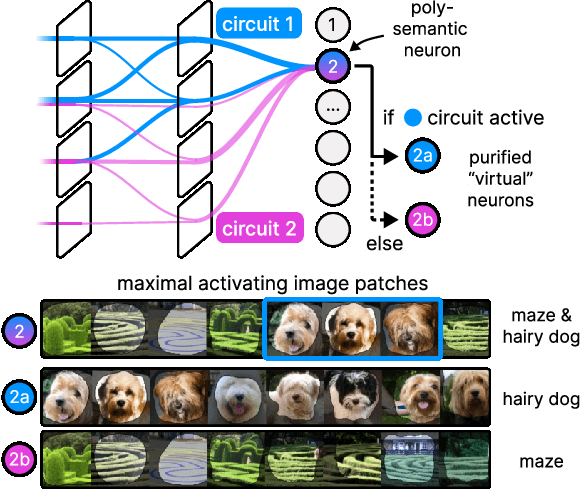


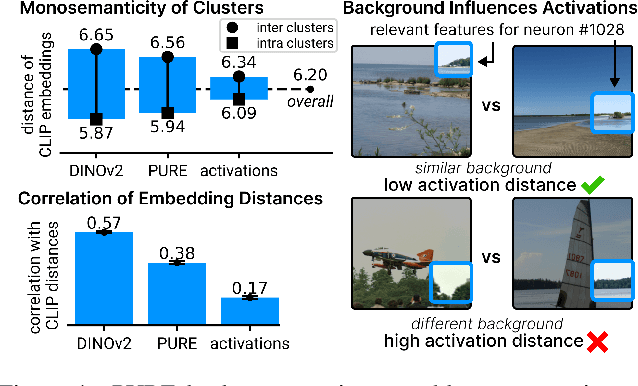
Abstract:The field of mechanistic interpretability aims to study the role of individual neurons in Deep Neural Networks. Single neurons, however, have the capability to act polysemantically and encode for multiple (unrelated) features, which renders their interpretation difficult. We present a method for disentangling polysemanticity of any Deep Neural Network by decomposing a polysemantic neuron into multiple monosemantic "virtual" neurons. This is achieved by identifying the relevant sub-graph ("circuit") for each "pure" feature. We demonstrate how our approach allows us to find and disentangle various polysemantic units of ResNet models trained on ImageNet. While evaluating feature visualizations using CLIP, our method effectively disentangles representations, improving upon methods based on neuron activations. Our code is available at https://github.com/maxdreyer/PURE.
AttnLRP: Attention-Aware Layer-wise Relevance Propagation for Transformers
Feb 08, 2024



Abstract:Large Language Models are prone to biased predictions and hallucinations, underlining the paramount importance of understanding their model-internal reasoning process. However, achieving faithful attributions for the entirety of a black-box transformer model and maintaining computational efficiency is an unsolved challenge. By extending the Layer-wise Relevance Propagation attribution method to handle attention layers, we address these challenges effectively. While partial solutions exist, our method is the first to faithfully and holistically attribute not only input but also latent representations of transformer models with the computational efficiency similar to a singular backward pass. Through extensive evaluations against existing methods on Llama 2, Flan-T5 and the Vision Transformer architecture, we demonstrate that our proposed approach surpasses alternative methods in terms of faithfulness and enables the understanding of latent representations, opening up the door for concept-based explanations. We provide an open-source implementation on GitHub https://github.com/rachtibat/LRP-for-Transformers.
Understanding the (Extra-)Ordinary: Validating Deep Model Decisions with Prototypical Concept-based Explanations
Nov 28, 2023Abstract:Ensuring both transparency and safety is critical when deploying Deep Neural Networks (DNNs) in high-risk applications, such as medicine. The field of explainable AI (XAI) has proposed various methods to comprehend the decision-making processes of opaque DNNs. However, only few XAI methods are suitable of ensuring safety in practice as they heavily rely on repeated labor-intensive and possibly biased human assessment. In this work, we present a novel post-hoc concept-based XAI framework that conveys besides instance-wise (local) also class-wise (global) decision-making strategies via prototypes. What sets our approach apart is the combination of local and global strategies, enabling a clearer understanding of the (dis-)similarities in model decisions compared to the expected (prototypical) concept use, ultimately reducing the dependence on human long-term assessment. Quantifying the deviation from prototypical behavior not only allows to associate predictions with specific model sub-strategies but also to detect outlier behavior. As such, our approach constitutes an intuitive and explainable tool for model validation. We demonstrate the effectiveness of our approach in identifying out-of-distribution samples, spurious model behavior and data quality issues across three datasets (ImageNet, CUB-200, and CIFAR-10) utilizing VGG, ResNet, and EfficientNet architectures. Code is available on https://github.com/maxdreyer/pcx.
From Hope to Safety: Unlearning Biases of Deep Models by Enforcing the Right Reasons in Latent Space
Aug 18, 2023Abstract:Deep Neural Networks are prone to learning spurious correlations embedded in the training data, leading to potentially biased predictions. This poses risks when deploying these models for high-stake decision-making, such as in medical applications. Current methods for post-hoc model correction either require input-level annotations, which are only possible for spatially localized biases, or augment the latent feature space, thereby hoping to enforce the right reasons. We present a novel method ensuring the right reasons on the concept level by reducing the model's sensitivity towards biases through the gradient. When modeling biases via Concept Activation Vectors, we highlight the importance of choosing robust directions, as traditional regression-based approaches such as Support Vector Machines tend to result in diverging directions. We effectively mitigate biases in controlled and real-world settings on the ISIC, Bone Age, ImageNet and CelebA datasets using VGG, ResNet and EfficientNet architectures.
 Add to Chrome
Add to Chrome Add to Firefox
Add to Firefox Add to Edge
Add to Edge